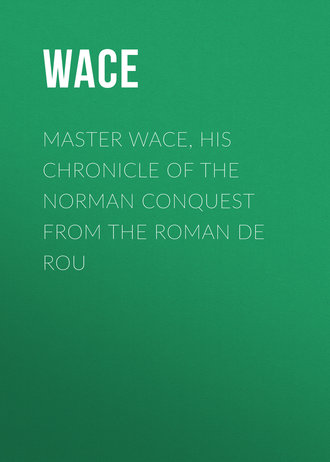 полная версия
полная версияMaster Wace, His Chronicle of the Norman Conquest From the Roman De Rou
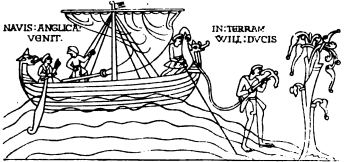

CHAPTER X.
HOW THE BARONS MET AT LILLEBONNE, AND WHAT AID THEY AGREED TO GIVE
To consult on this matter before he opened his mind to any other, he sent for Robert, the count d'Ou135, who dwelt by the men of Vimou136, and Rogier de Montgomeri, whom he accounted a great friend, and Fitz Osber of Bretuil, William by name, the proud of spirit; and for Gautier Giffart, a man of great worth; and for his brother Odun, the bishop, and Robert of Moretoin137, who was his brother also, and loved him much. Both these were his brothers, but only on the mother's side. He sent moreover for Rogier de Vilers138, who was much honoured and esteemed for his wisdom, and was now of considerable age, having sons who were already noble and brave knights. He was lord of Belmont-le-Rogier139, and possessed much land. And he sent also for Iwun al Chapel, who had Muriel to wife, sister of the duke on the mother's side, Herluin being her father140. I know not if children were born to them; I never heard speak of any.
To these barons he told his design, before he made any great preparation. He told them how he had lost his right, which Harold had seized; and that if they approved, he would cross the sea to avenge himself. If they were willing, he could easily recover his right by the aid of the people he could summon, and by God's permission. And they said they were all ready to go with him, if need were; and to pledge their lands, and even sell them, if necessary; that he need lose nothing of his right, but might rely on his men and his clerks. "You have," said they, "a great baronage, many valiant and wise men, who have very great power, and are as able as we to whom you speak: shew these things to them; all should be taken into counsel who have to share the labour."
So the barons were all summoned, and being assembled at a set day141, the duke shewed to them that Harold had cheated him, and had stolen the realm whereof Edward had made him heir; that he wished to avenge himself if he could, but that great aid was wanted; and that he could not, without their help, have many men and many ships, as he needed; let each say what he would do, how many men and ships he would bring. And they said they would speak together about it, and that after holding counsel, they would answer him; and he consented thereto.
They remained long in council; and the debate lasted a great while; for they hesitated long among themselves what they should say, what answer they should give, and what aid they would afford. They complained much to each other, saying that they had often been aggrieved; and they murmured much, conferring together in small parties; here five, there fifteen, here forty, there thirty, sixty, a hundred. Some said they were willing to bring ships and cross the sea with the duke; others said they would not go, for they owed much and were poor. Some would, others would not, and there was great contention amongst them.
Then Fitz Osber came forward and said, "Why do you go on wrangling with your natural lord, who seeks to gain honour? You ought never to be wanting. You owe him service for your fiefs, and what you owe him you ought to render with all your might. Wait not for him to beseech you; ask him for no respite; but go forward at once, and offer him even more than you can perform. Let him not have cause to complain, nor miss his undertaking on your account. If he fail, he will perchance soon say (for he is of a jealous temper) that you are the cause of his loss. Take care that he has not to say, that his expedition failed through you."
"Sire," said they, "we fear the sea, and we are not bound to serve beyond it; speak for us, we pray you, we put the speech upon you. You shall say what you will, and we will do accordingly." "Do you put it upon me?" said he. "Yes," said each, "I agree, let us go to the duke; speak for us, for you know our minds."
Then Fitz Osber went at their head, and spoke for them. "Sire, sire, look around; there is no people under Heaven that so love their lord, or that will do so much for his honour, as the people you have; and much should you love and protect them. They say that to advance you, they would swim through the sea, or throw themselves into the raging fire; you may trust them much, for they have served you long, and followed you at great cost, and they will willingly continue to serve you. If they have hitherto done well, they will hereafter do yet better. They will pass with you over sea, and double their service. He who should bring twenty knights, will cheerfully bring forty; he who should serve with thirty, will now serve you with sixty; and he who owes a hundred will willingly bring two hundred. For myself, I will in good love bring to my lord, in his need, sixty ships, well furnished and charged with fighting men."
At these words the barons marvelled and murmured much, grumbling loudly at the great promises he made, for which he had no warranty. Many began to disavow him, and the court became much troubled; great noise arose, and the barons stormed. They feared that doubling their service would be turned into a charge on their fiefs, that it would grow to a custom, and would thenceforth become permanently due. The assembly was greatly troubled, the noise was great, and the clamour loud. No one could hear another speak; no one could either listen to reason, or render it for himself.
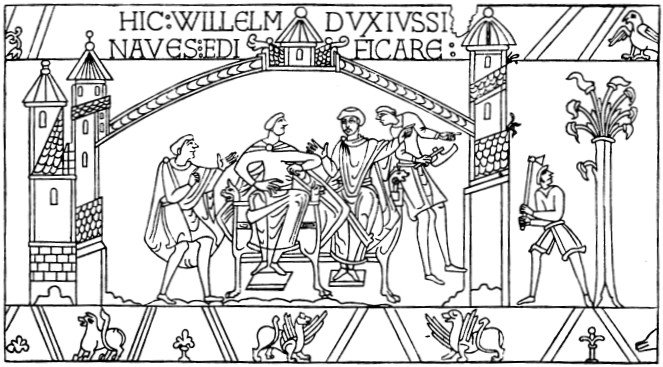
Then the duke, being greatly disturbed by the noise, drew on one side, and sent for the barons one by one; and spoke with and entreated each, telling them what need he had; how much they stood in his love and grace; and that if they doubled their service, and did of their own accord more than they were bound in this undertaking, they would do well; but he pledged himself that they should not be called on in future for service beyond what was the custom of the land, and such as their ancestors were wont to do for their lord142. Each said what he would do, and how many ships he could bring; and the duke had it all recorded at once, numbering the ships and knights which the barons agreed to find; thus each named how many knights he would provide, and how many ships he could bring. Of his brother Odo, the bishop, he received forty ships as a gift. The bishop of Mans furnished thirty ships with their crews; for he desired much to advance the duke. Each of the barons in like manner promised ships, but how many each one said he would bring I do not know143.
Then the duke called on his good neighbours, the Bretons, Mansels, and Angevins, and those of Pontif and Boloigne, to come with him in his need. To those who wished he promised lands, if he should conquer England. To many he promised other rewards, good pay, and rich gifts. From all sides he summoned soldiers who would serve for hire.
He shewed to the king of France his lord, how for good cause and for his honour's sake he was about to cross the sea against Harold, who had broken faith and defrauded him. The duke went to speak with the king at St. Girmer144 in Belveisen. He sought and found him there, and told him his situation, and that if he would aid him, and if by his help he should have his right, he would hold England of him, and would willingly serve him for it.
But the king of France said he would not do it, and that with his consent William should not go. For the French had besought their king, and counselled him not to advance the duke, or suffer him to strengthen himself. They said he was too strong already, and that it would be foolish to let him become still stronger; for if he were allowed to add the great power beyond sea, the wealth and great force of England, to the good chivalry and pride of Normandy, the king would never have peace in his life; he therefore ought rather to think of disturbing William, and preventing his rising higher, or passing into England. "You cannot aid the duke if you would," they said, "without means and money; all France would thereby be injured and impoverished, and therefore no Frenchman will follow you; no one will pass the sea, and if mischance befall you, you will be brought to great shame. The duke seeks your aid only for his own interest, for no good can come of it to you. When he shall have conquered England, you will have no more service from him; he serves you but little now, and he will then serve you still less. The more he has, the less he will do for you."
After what the Frenchmen said, still more and more opposing it, the king would not assist the duke, but rather hindered him all he could. I know not exactly what the king answered, but I know well that he failed him altogether. When the duke took leave of him, he said like a man who is wroth at heart, "Sire, I will go, and will do the best I can. If God please, I will seek my right. If I win it (which God grant) you shall do me no harm; and if the English are able to defend themselves, so that I fail, I shall not lose heart or head on that account. All things shall be set in order145; my children shall have my land, and you shall not take any advantage of them; whether I die or live, whatever befall me, I fear the threats of no man." Then William tried no more to persuade the king, but went his way.
He besought the count of Flanders146 to go with him as his brother-in-law and friend; but the count answered, that if he would make sure of aid from him, he must first let him know what share of England he was to have, and what division he would make of the spoil.
The duke said that he would go and talk with his barons about the matter, and take their counsel, and afterwards state by letter what they advised him to do. So he went away without more ado, and did such a thing as no one ever did before; for he took a small piece of parchment which had neither letter nor writing upon it, sealed it up with wax, all blank as it was, and wrote upon the label that the count should have such part of England as the letter within stated.
Then he sent the letter to the count by a cunning varlet147, who had long been with him; and the varlet delivered it to the count, who broke the seal, and opened the parchment, and looked within, but saw nothing. So he shewed it to the messenger, and the shrewd varlet said to him off hand, "Nought is there, and nought shalt thou have! therefore look for nothing! The honour that the duke seeks will be for your sister and nephews as much as for himself; and if he and they should win England, no one would have more advantage from their success than yourself. All theirs would in truth be yours. If God please, he will conquer it by himself, and seek none of your help." What the count answered I know not, but the varlet thereupon went his way.
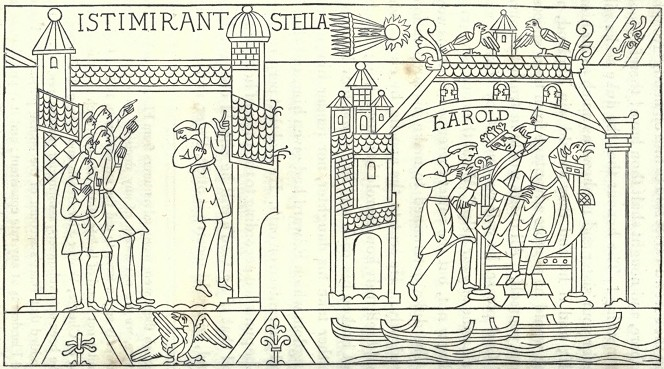
The duke determined to make his preparations prudently. He sent to the apostle, by clerks who could tell truly how Harold had used him; how he had broken his oath and lied; and how he would neither take his daughter, nor render him up the kingdom which Edward had given him, and Harold had guaranteed on oath. He said that perjury ought to be punished according to the rules of holy church; and that if by God's will he should conquer England, he would receive it of St. Peter, and do service for it to none but God. The apostle granted his request, and sent him a gonfanon148, and a very precious, rich and fair ring, which, he said, had under the stone one of Saint Peter's hairs149. With these tokens he commanded, and in God's name granted to him, that he should conquer England, and hold it of Saint Peter.
Now while these things were doing, a great star appeared, shining for fourteen days, with three long rays streaming towards the south; such a star as is wont to be seen when a kingdom is about to change its king. I have seen many men who saw it, men of full age at the time, and who lived many years after150. Those who discourse of the stars would call it a comet151.
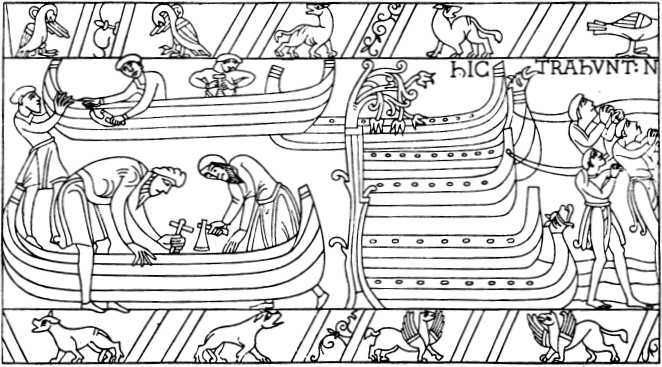
CHAPTER XI.
HOW THE NORMAN HOST MET AT ST. VALERY, AND SAILED THENCE
The duke rejoiced greatly at receiving the gonfanon, and the license which the apostle gave him. He got together carpenters smiths and other workmen, so that great stir was seen at all the ports of Normandy, in the collecting of wood and materials, cutting of planks, framing of ships and boats, stretching sails, and rearing masts, with great pains and at great cost. They spent all one summer and autumn in fitting up the fleet and collecting the forces; and there was no knight in the land, no good Serjeant, archer, nor peasant of stout heart, and of age for battle, that the duke did not summon to go with him to England: promising rents to the vavassors, and honors to the barons.
When the ships were ready, they were moored in the Somme at St Valeri, and there delivered to the barons. Many were the ships and boats in the river there, which is called the Somme, and separates Ponthieu and Vimou. Vimou extends as far as Ou, which separates Normandy from Vimou, a country under different government. Ou is a river, and Ou is also a fair castle152 situate upon that river.
The duke had men from many and various parts. Haimon, the viscount of Toarz153 came thither, a man of very great power, who could bring much people. Alain Felgan also came to the crossing, and brought with him great baronage from among the Bretons154; and Fitz Bertran de Peleit, and the Sire de Dinan came also; and Raol de Gael, and many Bretons from many castles, and from about Brecheliant, concerning which the Bretons tell many fables. It is a forest long and broad, much famed throughout Brittany. The fountain of Berenton rises from beneath a stone there. Thither the hunters are used to repair in sultry weather; and drawing up water with their horns, they sprinkle the stone for the purpose of having rain, which is then wont to fall, they say, throughout the whole forest around; but why I know not. There, too, fairies are to be seen (if the Bretons tell truth) and many other wonders happen. The ground is broken and precipitous, and deer in plenty roam there, but the husbandmen have deserted it. I went thither on purpose to see these marvels. I saw the forest and the land, and I sought for the marvels, but I found none155. I went like a fool, and so I came back; I sought after folly, and hold myself a fool for my pains.
The fame of the Norman duke soon went forth through many lands; how he meant to cross the sea against Harold, who had taken England from him. Then soldiers came flocking to him, one by one, two by two, and four by four; by fives and sixes, sevens and eights, nines and tens; and he retained them all, giving them much and promising more. Many came by agreement made with them beforehand; many bargained for lands, if they should win England; some required pay, allowances and gifts; and the duke was often obliged to give at once to those who could not wait the result156.
I shall never put in writing, and would not undertake to set down, what barons, and how many knights, how many vavassors, and how many soldiers the duke had in his company, when he had collected all his navy; but I heard my father say—I remember it well, although I was but a lad—that there were seven hundred ships, less four157, when they sailed from St. Valeri; and that there were besides these ships, boats and skiffs for the purpose of carrying the arms and harness. I have found it written (but I know not whether it be true) that there were in all three thousand vessels bearing sails and masts. Any one will know that there must have been a great many men to have furnished out so many vessels.
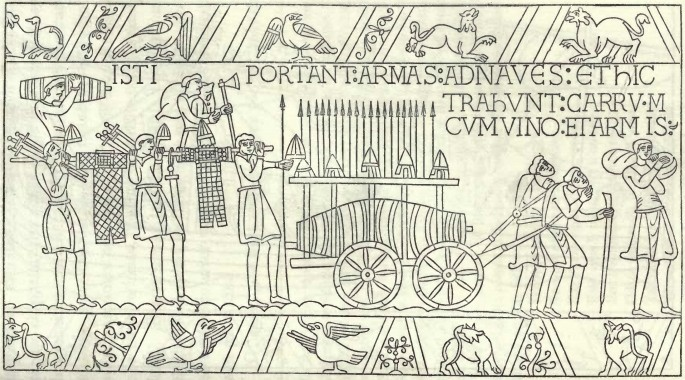
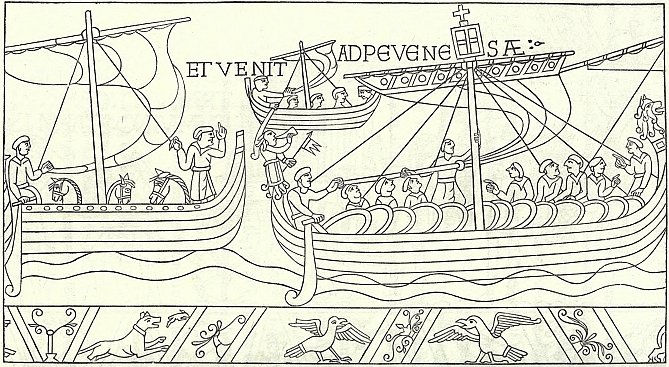
They waited long at St. Valeri for a fair wind, and the barons were greatly wearied158. Then they prayed the convent to bring out the shrine of St Valeri, and set it on a carpet in the plain; and all came praying the holy reliques, that they might be allowed to pass over sea. They offered so much money, that the reliques were buried beneath it; and from that day forth, they had good weather and a fair wind. The duke placed a lantern on the mast of his ship, that the other ships might see it, and hold their course after it. At the summit was a vane159 of brass, gilt. On the head of the ship, in the front, which mariners call the prow, there was the figure of a child in brass, bearing an arrow with a bended bow.160 His face was turned towards England, and thither he looked, as though he was about to shoot; so that whichever way the ship went, he seemed to aim onwards.
Of so large a fleet with so many people, only two ships were in any peril, and those perhaps from being overloaded. The duke had a great chivalry in his ships; and besides these, he had many archers and Serjeants, many brave men and warriors, carpenters and engineers, good smiths and other handicraftsmen.
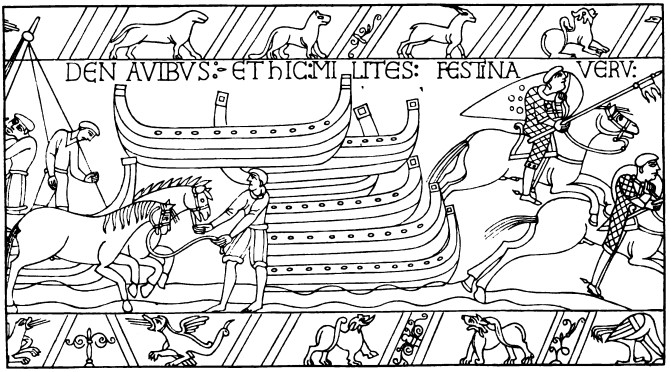
CHAPTER XII.
HOW THE DUKE AND HIS HOST LANDED NEAR TO HASTINGS, AND MADE THEMSELVES A FORT
The ships steered to one port; all arrived and reached the shore together; together cast anchor, and ran on dry land; and together they discharged themselves. They arrived near Hastings, and there each ship ranged by the other's side. There you might see the good sailors, the Serjeants and squires sally forth and unload the ships; cast the anchors, haul the ropes, bear out shields and saddles, and land the warhorses and palfreys. The archers came forth, and touched land the foremost; each with his bow bent, and his quiver full of arrows slung at his side. All were shaven and shorn, and all clad in short garments, ready to attack, to shoot, to wheel about and skirmish. All stood well equipped, and of good courage for the fight; and they scoured the whole shore, but found not an armed man there. After the archers had thus gone forth, the knights landed next, all armed; with their hauberks on, their shields slung at their necks, and their helmets laced. They formed together on the shore, each armed upon his warhorse. All had their swords girded on, and passed into the plain with their lances raised.
The barons had gonfanons, and the knights pennons. They occupied the advanced ground, next to where the archers had fixed themselves. The carpenters, who came after, had great axes in their hands, and planes and adzes hung at their sides. When they had reached the spot where the archers stood, and the knights were assembled, they consulted together, and sought for a good spot to place a strong fort upon. Then they cast out of the ships the materials, and drew them to land, all shaped framed and pierced to receive the pins which they had brought, cut and ready in large barrels; so that before evening had well set in, they had finished a fort. Then you might see them make their kitchens, light their fires, and cook their meat. The duke sat down to eat, and the barons and knights had food in plenty; for he had brought ample store. All ate and drank enough, and were right glad that they were ashore.
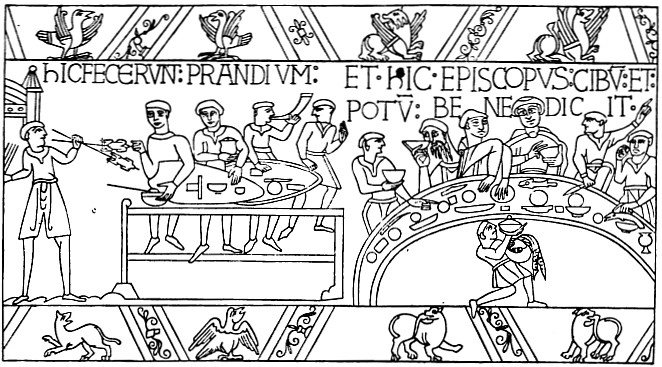
Before the duke left the Somme, a clerk had come to him, who knew, he said, astronomy and necromancy, and held himself a good diviner, and predicted many things. So he divined for the duke, and predicted that he should pass the sea safely, and succeed in his expedition, without fighting at all; for that Harold would make such promises, and come to such terms, that he would hold the land of the duke, and become his liegeman, and so William would return in safety. As to the good passage, he predicted right enough; but as to not fighting, he lied. When the duke had crossed, and arrived safely, he remembered the prediction, and inquired for the diviner. But one of the sailors said he had miscarried and was drowned at sea, being in one of the lost ships. "Little matters it," said the duke; "no great deal could he have known. A poor diviner indeed must he be about me, who could predict nought about himself. If the things to come were known to him, he might well have foreseen his own death; foolish is he who trusts in a diviner, who takes heed for others but forgets himself; who knows the end of other men's work, and can not discern the term of his own life." Such was the end of the diviner.
As the ships were drawn to shore, and the duke first landed, he fell by chance upon his two hands. Forthwith all raised a loud cry of distress, "An evil sign," said they, "is here." But he cried out lustily, "See, seignors, by the splendour of God! I have seized England with my two hands; without challenge no prize can be made; all is our own that is here; and now we shall see who will be the bolder man." Then one of his men ran forward and put his hand on a hut, and took a handful of the thatch, and turned to the duke, saying heartily, "Sire, come forward and receive seizin; of this land I give you seizin; without doubt the country is yours." And the duke said, "I accept it; may God be with us."
Then he ordered proclamation to be made, and commanded the sailors that the ships should be dismantled, and drawn ashore and pierced, that the cowards might not have the ships to flee to161.
All cannot be told or written at once; but, passing backward and forward to each matter in its turn, I have now to tell that the duke immediately after his arrival made all his host arm themselves.
The first day they held their course along the sea-shore; and on the morrow came to a castle called Penevesel162. The squires and foragers, and those who looked out for booty, seized all the clothing and provisions they could find, lest what had been brought by the ships should fail them; and the English were to be seen fleeing before them, driving off their cattle, and quitting their houses. All took shelter in the cemeteries163, and even there they were in grievous alarm.
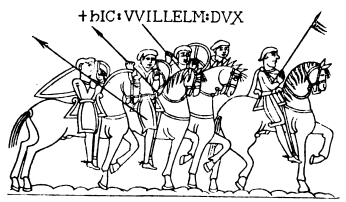
CHAPTER XIII.
HOW AN ENGLISH KNIGHT RODE TO HAROLD WHO WAS FIGHTING TOSTI; AND WHAT MESSAGE WAS SENT BY THE DUKE
A knight of that country heard the noise and cry made by the peasants and villains when they saw the great fleet arrive. He well knew that the Normans were come, and that their object was to seize the land. He posted himself behind a hill, so that they should not see him, and tarried there, watching the arrival of the great fleet. He saw the archers come forth from the ships, and the knights follow. He saw the carpenters with their axes, and the host of people and troops. He saw the men throw the materials for the fort out of the ships. He saw them build up and enclose the fort, and dig the fosse around it. He saw them land the shields and armour. And as he beheld all this, his spirit was troubled; and he girt his sword and took his lance, saying he would go straightway to king Harold, and tell the news. Forthwith he set out on his way, resting late and rising early; and thus he journeyed on by night and by day to seek Harold his lord.
He found him beyond the Humber, in a town where he had just dined164. Harold carried himself very loftily, for he had been beyond Humber, and had had great success in overcoming Tosti. Tosti was Harold's brother; but unfortunately they had become enemies, and Tosti had sent his friends to Harold, calling upon him to give him his father's fief, now that it had fallen out, that, right or wrong, he had become king; and requiring him to let him have the lands their father held by inheritance; and he promised on this being done to ask no more; but to become his man, and acknowledge him for lord, and serve him as well as he did King Edward.

